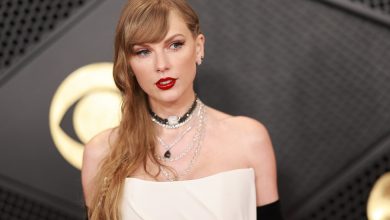Review: In Miami, a ‘Swan Lake’ That Blasts Off the Cobwebs

MIAMI — The swans make all the difference.
Alexei Ratmansky’s “Swan Lake,” performed by Miami City Ballet in its North American premiere on Friday night, is full of surprises. Perhaps the biggest is how his swans aren’t quivering birds, but women — radiant in their carriage, glowing in their classicism.
Their arms rarely come close to a ripple and when they do, as in the ballet’s final haunting moments, it is to show a unified front: As their arms rise and lower, the image has more to do with weeping than flapping. These are not the arms of birds trying to escape, but something softer and creamier and, all the while, fluidly connected to the back. As they carve the air, bodies follow, bending and curving in transcendent motion.
It’s a subtle difference that changes everything. As women, these swans are no longer creatures (that unfortunate word sometimes used to describe dancers), but something more empowered. And they’re lovely. Jérôme Kaplan’s designs bring a delightful, youthful air to the stage, particularly his graceful, rounded tutus for the swans that land just above the knee, and their white feathered caps and low, ringlet ponytails. Odette dons a crown instead of a feather headpiece. The details add up; they take “Swan Lake” out of a storybook, and bring it into focus. It’s still a fantasy but it’s not childishly fanciful.
The swans aren’t the only reason that Ratmansky’s version, which he based on Marius Petipa and Lev Ivanov’s 1895 St. Petersburg production, using notations written a decade after its premiere, feels so modern. It’s crisp and refreshingly clean. Performed at the Adrienne Arsht Center for the Performing Arts here, “Swan Lake” is one of Ratmansky’s greatest successes in using notations to take a dusty jewel, examine it from all angles and wipe away its grime — in this case, decades of stale and ponderous interpretations.
In Ratmansky’s sophisticated rendering, which he refers to in a Miami City Ballet video as a “historically informed production” rather than a reconstructed ballet, the dancing is alive as it lends flavor and picturesque richness to Tchaikovsky’s score. In this version, originally presented by Zurich Ballet and La Scala Ballet in 2016, the pas de trois, performed Friday by Samantha Hope Galler, Alexander Peters and Nicole Stalker, comes first.
It was a bright entry point to the look of the choreography to follow — musical, daring within its precision — and a potent contrast to the world that was to follow, where Prince Siegfried (the sunny, noble Renan Cerdeiro), during a lakeside hunting excursion, encounters and falls in love with Odette, the Queen of Swans (Katia Carranza, who also plays Odile). Again, she’s not a swan but a princess. Under the spell of the evil Von Rothbart, she and her maidens transform into swans during the day. At night, they are human.
What can break the spell? The answer is the same as it ever was: true love. In Ratmansky’s ballet, which veers away from cartoonish details, this isn’t as silly or as simple as it sounds. In the lakeside scene when Siegfried first meets Odette, they share the stage with Benno (Damian Zamorano, who has a passing resemblance to Roger Daltrey), the prince’s friend who assists in partnering. That’s different.
Even though it’s two against one, the visual effect is less predatory than painterly. Benno projects a brotherly tenderness toward Odette as he rushes to her side to catch her in side falls. It’s almost uncanny, as if her body — a vessel of dismay and sadness — grasps that in Siegfried she may have finally found someone in the real world to lean on. And Benno, through his invisible partnering, is showing him the way.
Siegfried, when he steps in to partner her, touches her gingerly. After a turn he stills her body by holding her wrists, which are extended in a V overhead. It’s so fragile, this bond that they’re forming; it’s all about trust. And throughout, beautiful pantomime, simple yet clear, lends the dancing a rare kind of poetic prowess and urgency. When Odette crosses her wrists in front of her body, it means death, and she isn’t ethereal about it. There’s no gray line. Death means death.
Of course, Odette loses her faith in Siegfried after he meets Odile, Von Rothbart’s deceptive daughter, in the ballroom scene. Here, Ratmansky steers away from black swan imagery — Odile’s dark featherless dress is washed in shades of green and purple like an iridescent fish dipped in glitter. (The idea is right, but it looked a little cheap.) Siegfried, overcome by her likeness to Odette, begs her to marry him, which, of course, is the wrong move.
As Odette, Carranza was competent if a little indistinct, and her Odile lacked dazzle. But it was still enthralling to watch the choreography unfold, including a pose in her pas de deux with Cerdeiro in which her leg was extended in arabesque as he knelt before her. Suddenly, she let go of his hands and dropped hers on his front knee. It was so peculiar, yet it made sense. In a way, it’s part of her seduction: Odile, forcibly, pins Siegfried down.
But the power of Ratmansky’s “Swan Lake” lies in his use of groups. The Act 1 peasant waltz — in which dancers step on and off footstools, raising their arms high and low — is the most uplifting thing you’ve ever seen until moments later when a maypole is erected and layers of dancers swirl around it to create a human carousel. The pictures they form are so jovial, so sweet. Part of this has to have something to do with how warm and gracious these Miami City Ballet dancers are. As George Balanchine once said, dancing Tchaikovsky’s ballets is like flying. They fly.
The swans in this lake may be earthbound, but with their sweeping patterns and the way they crisply arrange themselves onstage, as a group or as a frame for Odette in Act 3, Ratmansky’s swans fly, too. They aren’t soulless, they’re sensual and luscious as they lament Odette’s fate. Ultimately, she leaps to her death and Siegfried follows.
In this “Swan Lake,” there is something luminous about their collective effort, their rich and foreboding sisterhood. In the final act, swans in black mingle with those in white as they glide across the stage pausing every now and then to form pictures — and gorgeous ones at that.
Lourdes Lopez, Miami City Ballet’s artistic director — and a former New York City Ballet principal — was smart to nab Ratmansky’s production. Isn’t it time for New York to have this “Swan Lake,” too? At American Ballet Theater, where Ratmansky is the artist in residence, the company’s production of “Swan Lake” lost its luster years ago (if it ever had it). City Ballet’s full-length version is tedious and by its former artistic leader, Peter Martins. That ship has sailed.
All of this is to say that I have the strangest feeling: I’ve finally seen “Swan Lake” and many more people should see it, too.
Swan Lake
Through Sunday at the Adrienne Arsht Center for the Performing Arts, Miami; Feb. 19-20 at the Kravis Center in West Palm Beach; and Feb. 26-27 at the Broward Center in Ft. Lauderdale, miamicityballet.org.




